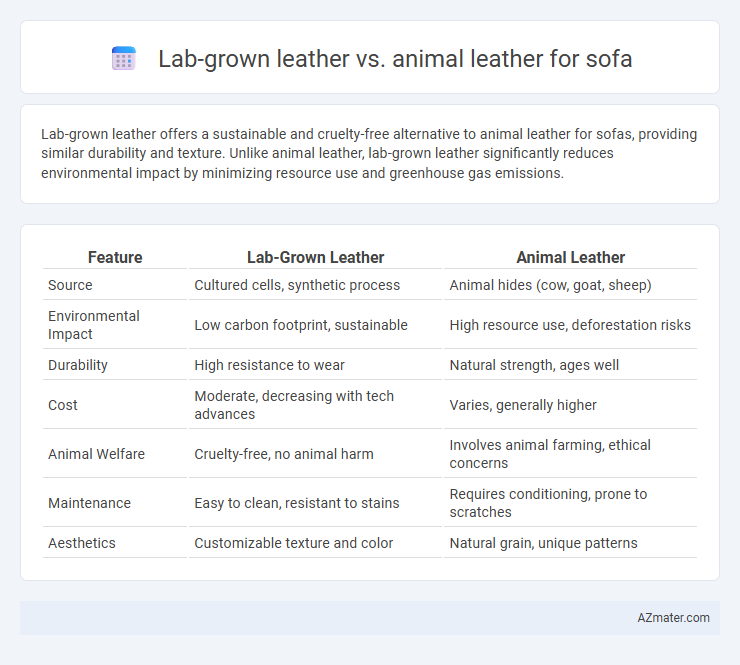Lab-grown leather offers a sustainable and cruelty-free alternative to animal leather for sofas, providing similar durability and texture. Unlike animal leather, lab-grown leather significantly reduces environmental impact by minimizing resource use and greenhouse gas emissions.
Table of Comparison
| Feature | Lab-Grown Leather | Animal Leather |
|---|---|---|
| Source | Cultured cells, synthetic process | Animal hides (cow, goat, sheep) |
| Environmental Impact | Low carbon footprint, sustainable | High resource use, deforestation risks |
| Durability | High resistance to wear | Natural strength, ages well |
| Cost | Moderate, decreasing with tech advances | Varies, generally higher |
| Animal Welfare | Cruelty-free, no animal harm | Involves animal farming, ethical concerns |
| Maintenance | Easy to clean, resistant to stains | Requires conditioning, prone to scratches |
| Aesthetics | Customizable texture and color | Natural grain, unique patterns |
Introduction to Sofa Leathers: Lab-Grown vs Animal
Lab-grown leather for sofas offers a sustainable and cruelty-free alternative to traditional animal leather, produced through cellular agriculture techniques that replicate the texture and durability of genuine leather. Animal leather, derived from the hides of cows and other livestock, remains prized for its natural grain, strength, and aging characteristics that enhance sofa aesthetics over time. Comparing these materials involves evaluating environmental impact, tactile quality, and long-term performance in upholstery applications.
Understanding Lab-Grown Leather Technology
Lab-grown leather for sofas is produced using advanced biofabrication techniques that cultivate collagen fibers from animal cells, creating a material nearly identical to traditional leather without using livestock. This technology leverages tissue engineering and 3D printing to form durable, customizable leather surfaces that reduce environmental impact compared to conventional animal leather production. Understanding lab-grown leather involves recognizing its potential for scalability, consistent quality, and eco-friendly manufacturing processes, making it a sustainable alternative for luxury furniture upholstery.
Animal Leather: Traditional Process and Sourcing
Animal leather for sofas is traditionally sourced from cattle hides, undergoing a complex tanning process that involves curing, dyeing, and finishing to enhance durability and aesthetic appeal. This leather type offers natural breathability, strength, and a unique patina that develops with age, contributing to its luxurious appeal. However, the sourcing and processing of animal leather raise concerns about environmental impact, including deforestation, water use, and chemical waste from tanning.
Sustainability and Environmental Impact Comparison
Lab-grown leather reduces reliance on animal farming, significantly lowering greenhouse gas emissions and water consumption compared to traditional animal leather used in sofas. It eliminates the need for chemical-intensive tanning processes, minimizing toxic waste and soil contamination commonly associated with conventional leather production. This sustainable alternative offers a lower carbon footprint and supports eco-friendly furniture manufacturing practices.
Durability and Performance on Sofas
Lab-grown leather offers comparable durability to traditional animal leather, maintaining resistance to wear, tearing, and stretching, which is essential for long-lasting sofas. Unlike animal leather, lab-grown variants provide enhanced consistency in quality and fewer imperfections, improving performance under regular use and minimizing maintenance needs. Both materials exhibit breathability and comfort, but lab-grown leather also integrates eco-friendly properties, supporting sustainable furniture production without compromising durability.
Comfort and Aesthetics: Feel and Look Differences
Lab-grown leather for sofas offers a consistently smooth texture and customizable finish, providing enhanced softness and uniformity compared to traditional animal leather, which may have natural imperfections and varying grain patterns. Animal leather boasts a classic, rich patina that develops character and depth over time, contributing to a luxurious aesthetic and a warm, inviting feel unmatched by synthetic alternatives. The comfort of lab-grown leather often includes superior breathability and resistance to temperature fluctuations, while animal leather excels in durability and natural suppleness that conforms uniquely to body contours.
Ethical Considerations: Animal Welfare and Innovation
Lab-grown leather offers a revolutionary alternative to traditional animal leather by eliminating the need for animal farming and slaughter, significantly reducing animal suffering and ethical concerns. This innovative material leverages cellular agriculture techniques to produce durable, high-quality leather without compromising animal welfare. Ethical considerations favor lab-grown leather as it supports sustainable innovation while minimizing the environmental impact tied to conventional leather production.
Cost Analysis: Lab-Grown vs Animal Leather Sofas
Lab-grown leather sofas typically have higher upfront costs compared to traditional animal leather due to advanced manufacturing processes and limited scale production. Over time, lab-grown leather can offer cost savings through enhanced durability and lower maintenance requirements, reducing replacement and repair expenses. Animal leather sofas generally involve variable costs influenced by factors such as animal breed, tanning techniques, and market demand, impacting overall affordability and long-term value.
Maintenance and Care for Each Leather Type
Lab-grown leather offers easier maintenance with higher resistance to stains and fading, requiring only regular dusting and occasional wiping with a damp cloth to preserve its appearance. Animal leather demands more meticulous care, including conditioning every 6-12 months to prevent cracking and using specialized cleaners to maintain suppleness and prevent damage from moisture. Both types benefit from avoiding direct sunlight and sharp objects, but lab-grown leather's synthetic durability simplifies upkeep for sofa use.
The Future of Sofa Upholstery: Trends and Consumer Preferences
Lab-grown leather is rapidly gaining traction in sofa upholstery due to its sustainability, ethical production, and customizable texture, appealing to eco-conscious consumers seeking alternatives to traditional animal leather. Advances in biotechnology have enhanced the durability and aesthetic qualities of lab-grown leather, positioning it as a viable option for modern furniture design. Consumer preferences increasingly favor lab-grown leather for its reduced environmental impact, aligning with trends toward circular economy practices and innovative materials in home furnishings.

Infographic: Lab-grown leather vs Animal leather for Sofa
 azmater.com
azmater.com